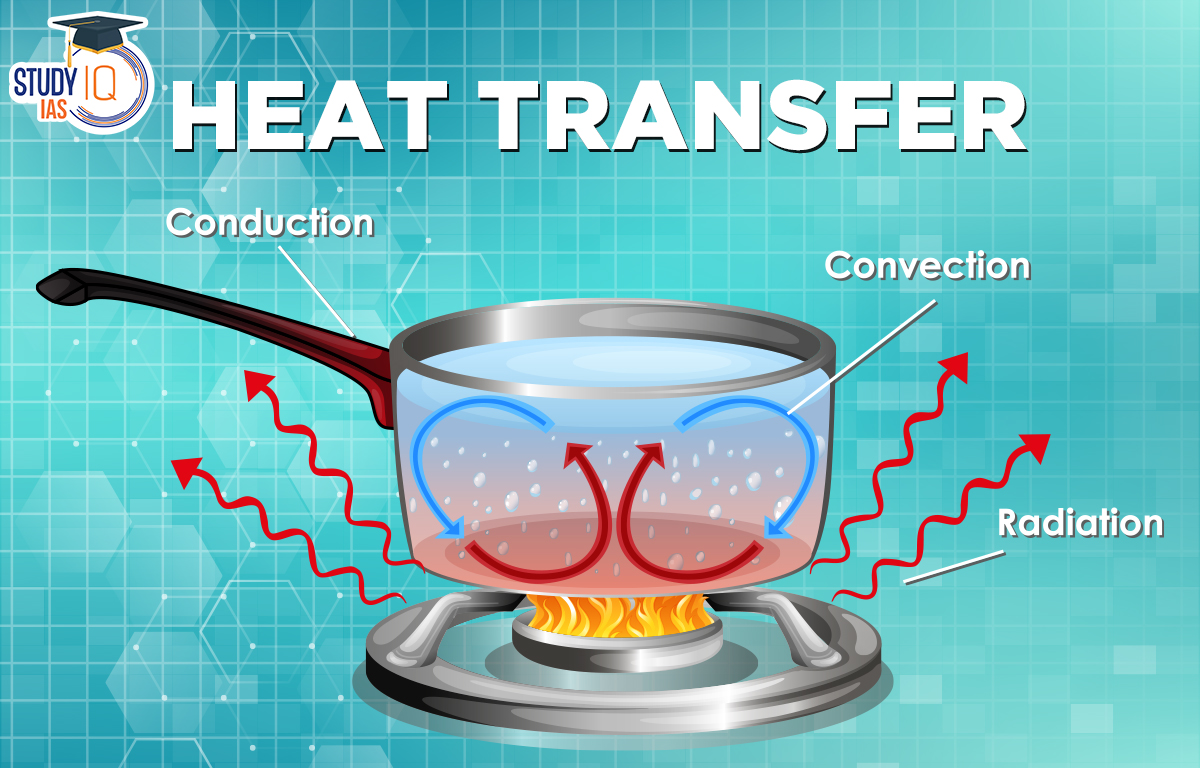Table of Contents
Heat Transfer
The Sun is a big, hot ball of gas that shines and sends out energy in all directions. This energy is the main source of power for Earth and all the other planets in our solar system. The radiated energy from the Sun received by the Earth’s surface is termed Insolation. However, the Earth receives only a minuscule part of this radiated energy from the Sun.
Land, water, clouds, gases, and dust absorb energy from the Sun. This energy creates different weather patterns, ocean currents, and plant growth. These effects vary in places like deserts, oceans, mountains, plains, rainforests, and icy areas. Apart from the interferences, the presence or absence of clouds in the atmosphere may have a difference of up to 75 percent in the amount of energy landing on the Earth’s surface.
Read More: Ocean Waves
Heat Transfer in Atmosphere
Solar energy is the primary source of heat. However, its effect is not directly realized. For example, as one climbs a mountain or ascends in the atmosphere, the temperature steadily lowers, rather than increases, which one might expect. This particular phenomenon is experienced as the mechanism of heating by solar insolation in the atmosphere is not very simple or uniform.
Read More: Structure of the Atmosphere
Types of Heat Transfer
There are four common types of energy transfer involved in heating the atmosphere. They are Radiation, Conduction, Convection and Advection.
Heat Transfer by Radiation
Heat Transfer by the process of radiation occurs when Heat Waves or energy are emitted through electromagnetic radiation without any medium. Heat transfer through radiation happens when the Sun’s rays travel through space and reach Earth. These rays consist of particles called photons that collide with air molecules, transferring energy. All objects emit radiation based on their temperature, with hotter objects emitting shorter wavelengths.
The Sun emits short wavelengths, like ultraviolet and visible light, which we feel as warmth. Meanwhile, the cooler Earth releases the heat it absorbs as longer wavelengths, called terrestrial radiation. The atmosphere allows short wavelengths to escape into space but absorbs longer wavelengths due to greenhouse gases like carbon dioxide and water vapor. As a result, the energy that leaves Earth’s surface heats the atmosphere more than the incoming solar energy does.
Heat Transfer by Conduction
When two objects of varying temperatures come in contact, heat energy flows from the warmer object to the cooler one. This process of transferring heat is known as conduction. The flow continues till the temperature of both objects reaches an equilibrium or the contact is broken.
Conduction in the atmosphere happens when the air touches the Earth’s surface through terrestrial radiation. However, it is a minor way of warming the atmosphere because it only affects the air in direct contact with the ground, and air is not a good conductor of heat.
Heat Transfer by Convection
Convection is the transfer of heat energy from one part of a liquid or a gas to another by the movement of particles themselves. When the bottom of a liquid is heated, the molecules there warm up and vibrate more. This makes them bump into nearby molecules, creating movement. As a result, the heated liquid expands, becomes less dense, and rises, carrying the heat with it. For example, upward-moving air is said to rise in a convection current. Thus, it transfers heat from warmer to cooler materials in this manner.
Heat Transfer by Advection
The transfer of heat by the horizontal movement of air is called advection. Mostly these atmospheric winds that blow over a region, take the region’s characteristics with them. The temperature of a place rises if it lies on the path of warmer winds. The temperature will dip if the place lies on the path of winds blowing from cold regions. In summer, ‘Loo’ of north India is a hot wind and ‘Sirocco’ is also a hot wind that carries the heat of the Sahara desert to Mediterranean regions. In the middle latitudes, most diurnal (day and night) variation in daily weather is caused by advection alone.
Comparison among Radiation, Conduction, Convection & Advection
| Radiation | Conduction | Convection | Advection |
| Heat transfer by the process of radiation occurs when heat waves or energy are emitted through electromagnetic radiation. | When two objects of varying temperatures come in contact, heat energy flows from the warmer object to the cooler one until equilibrium is achieved. | Convection is the transfer of heat energy from one part of a fluid (liquid or gas) to another by the movement of particles themselves. | Heat transfer results from the movement of warm molecules of fluid to the cooler molecules of a fluid in a horizontal manner. |
| Does Not require any medium for heat transfer. Heat can be transferred in a vacuum space also. | Requires a medium for heat transfer. | Requires a medium for heat transfer. | Requires a medium for heat transfer. |
| Heat transfers through electromagnetic radiation. Meaning no physical contact is required between the bodies. | Heat transfers through direct contact. Physical contact is required. | Heat transfers through the intermediary substances due to temperature differences. | Heat transfers through the intermediary substances due to pressure and temperature differences. |
| The rate of heat transfer is fast. | The rate of heat transfer is slow. | The rate of heat transfer is slow. | The rate of heat transfer is slow. |
| Heat transfer mostly occurs between two bodies with or without a medium. | Occurs in solids through molecular collisions. | Occurs in fluids by the flow of heat in the molecules in a vertical direction. | Occurs in fluids by the flow of heat in the molecules in a horizontal direction. |
Heat Transfer UPSC
The environment can be heated & cooled in a variety of ways. After being warmed by insolation, the earth radiates heat in a long waveform to the upper atmosphere.
There are three distinct processes that are primarily responsible for the heating and cooling of the Earth’s atmosphere. Conduction, Convection, and Advection—three crucial processes—are briefly discussed in this article. This article’s content will be useful for the UPSC exam. This material will be of great use to candidates as they get ready for the IAS Exam.


 Indus Valley Civilization, History, Phas...
Indus Valley Civilization, History, Phas...
 Summer Solstice, Definition, Reason and ...
Summer Solstice, Definition, Reason and ...
 Bihar Caste Census Report 2023, Caste Wi...
Bihar Caste Census Report 2023, Caste Wi...





















